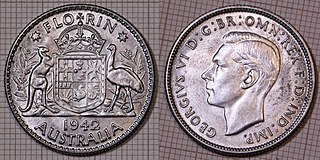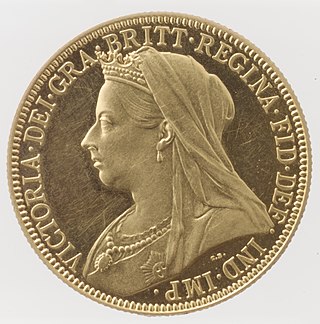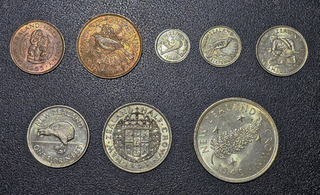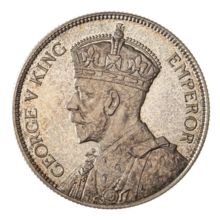
The standard circulating coinage of the United Kingdom, British Crown Dependencies and British Overseas Territories is denominated in pennies and pounds sterling, and ranges in value from one penny sterling to two pounds. Since decimalisation, on 15 February 1971, the pound has been divided into 100 (new) pence. Before decimalisation, twelve pence made a shilling, and twenty shillings made a pound.

The British florin, or two-shilling piece, was a coin worth 1⁄10 of one pound, or 24 pence. It was issued from 1849 until 1967, with a final issue for collectors dated 1970. It was the last coin circulating immediately prior to decimalisation to be demonetised, in 1993, having for a quarter of a century circulated alongside the ten-pence piece, identical in specifications and value.

The pound was the currency of Australia from 1910 until 14 February 1966, when it was replaced by the Australian dollar. Like other £sd currencies, it was subdivided into 20 shillings, each of 12 pence.
George Edward Kruger Gray was an English artist, best remembered for his designs of coinage and stained glass windows.
There have been three sets of coins in Ireland since independence. In all three, the coin showed a Celtic harp on the obverse. The pre-decimal coins of the Irish pound had realistic animals on the reverse; the decimal coins retained some of these but featured ornamental birds on the lower denominations; and the euro coins used the common design of the euro currencies. The pre-decimal and original decimal coins were of the same dimensions as the same-denomination British coins, as the Irish pound was in currency union with the British pound sterling. British coins were widely accepted in Ireland, and conversely to a lesser extent. In 1979 Ireland joined the Exchange Rate Mechanism and the Irish pound left parity with sterling; coin designs introduced after this differed between the two countries.
The coins of the South African pound were part of the physical form of South Africa's historical currency, the South African pound. Prior to the Union of 1910, various authorities issued their own pounds, some as independent entities. After the Union but before 1923, coins in circulation were mostly British, but the coins of Paul Kruger's South African Republic remained in circulation. In 1923, South Africa began to issue its own coins, adopting coins that were identical in size and value to those used in Great Britain: 12 pence (12d) = 1 shilling (1s), and 20s = 1 pound (£1). On 14 February 1961, the Union of South Africa adopted a decimal currency, replacing the pound with the Rand.

The Australian florin was a coin used in the Commonwealth of Australia before decimalisation in 1966. The florin was worth two shillings . The denomination was first minted in 1910 to the same size and weight as the British florin.
The coins of the New Zealand dollar are used for the smallest physical currency available in New Zealand. The current denominations are ten cents, twenty cents, fifty cents, one dollar and two dollars. The $1 and $2 coins are minted in a gold colour, the 20c and 50c coins are silver colour and the 10c coin is plated in copper.

The shilling, informally called a "bob", was a type of silver coinage issued by the Commonwealth of Australia, that circulated prior to the decimalisation of Australian coinage. The Australian shilling was derived from the British pre-decimal sterling pound system and was first issued following the passing of the Australian Coinage Act 1909, which established Australia's first formal currency system. The shilling was issued as part of Australia's silver coinage, which included the two-shilling (florin), the sixpence and the threepence. The shilling was minted from 1910 until 1963. During this period there was one significant modification to the design of the Australian shilling, the change in its reverse design, which occurred in 1938 when the design was altered from the Australian coat of arms (1910–1936) to the visage of a Merino ram's head (1938–1963).

The Jubilee coinage or Jubilee head coinage are British coins with an obverse featuring a depiction of Queen Victoria by Joseph Edgar Boehm. The design was placed on the silver and gold circulating coinage beginning in 1887, and on the Maundy coinage beginning in 1888. The depiction of Victoria wearing a crown that was seen as too small was widely mocked, and was replaced in 1893. The series saw the entire issuance of the double florin (1887–1890) and, in 1888, the last issue for circulation of the groat, or fourpence piece, although it was intended for use in British Guiana. No bronze coins were struck with the Jubilee design.

The Old Head coinage or Veiled Head coinage were British coins struck and dated between 1893 and 1901, which featured on the obverse a portrait by Thomas Brock of an aged Queen Victoria wearing a diadem partially hidden by a widow's veil. It replaced the Jubilee coinage, struck since 1887, which had been widely criticised both for the portrait of the Queen, and because the reverses of most of the coins did not state their monetary values. Some denominations continued with their old reverse designs, with Benedetto Pistrucci's design for the sovereign extended to the half sovereign. New designs for some of the silver coinage were inaugurated, created either by Brock or by Edward Poynter, and all denominations less than the crown, or five-shilling piece, stated their values.

The halfpenny was first issued in New Zealand in 1940, seven years after the first introduction of a domestic pound coinage. The coin's issuing was scheduled to align with the centennial of the Treaty of Waitangi and the New Zealand centennial, alongside the penny and centennial half-crown. The coin was designed by New Zealand artist Leonard Cornwall Mitchell after winning a government-sponsored design competition, and then modelled by Royal Mint designer Percy Metcalfe. The halfpenny features the head of the reigning monarch on the obverse, with a hei-tiki pendant ornamented and simplified kowhaiwhai woodcarvings on the reverse. The smallest of all denominations of the New Zealand pound, the copper coin was worth 1/480th of a pound, or 1/120th of a crown, the largest coinage denomination. It was discontinued alongside all other New Zealand currency following decimalisation in 1967.

The Waitangi crown is a commemorative crown coin struck in 1935 by the British Royal Mint for the Dominion of New Zealand to commemorate the 1840 signing of the Treaty of Waitangi, often seen as New Zealand's founding constitutional document. It was the first five-shilling piece minted of the New Zealand pound and the nation's first coin minted primarily for collectors. Following the rejection of designs by James Berry and George Kruger Gray, Royal Mint designer Percy Metcalfe was commissioned to design the reverse. Design disagreements plagued the production of the crown, and only an extremely small mintage of 1,128 was struck and distributed to collectors. Released to muted media coverage and a general lack of interest in coin collecting during the economic aftermath of the Great Depression, the coin has become heavily sought by collectors of New Zealand coinage. Regularly selling for thousands of dollars, one pattern issue of the coin auctioned at over $70,000 USD, becoming the most expensive New Zealand coin ever sold.

The first coinage of the New Zealand pound was introduced in 1933 in response to large-scale smuggling of prior British imperial coinage after devaluation of New Zealand exchange rates relative to the pound sterling and large influxes of other foreign coinage into circulation. The Coinage Act, 1933 outlined the weights and compositions of various denominations, out of which five silver issues entered circulation over the following year, after lengthy disagreement between rival coinage design committees. The copper penny and halfpenny entered circulation in 1940, corresponding to anniversary of the New Zealand centennial. An eighth denomination of coin, the five-shilling piece or crown, was produced solely through three commemorative issues. The first issue, the Waitangi crown, was produced in extremely limited quantities and sold to collectors. Later commemorative crown issues in 1949 and 1953 were produced for circulation.

The New Zealand penny is a large bronze coin issued from 1939 to 1965. Introduced seven years after the larger denominations of New Zealand pound coinage, the coin's issuing was scheduled to align with the centennial of the Treaty of Waitangi and the New Zealand centennial, alongside the halfpenny and centennial half-crown. Featuring the standard portrait of the ruling monarch on the obverse, the reverse features a tūī bird perched atop a kōwhai branch.

The New Zealand shilling was first issued in 1933 alongside four other denominations of New Zealand pound coinage, introduced due to shortages of comparable British silver coinage following the devaluation of the New Zealand pound relative to the pound sterling. Roughly 24 mm in diameter, it is slightly larger than the British coin it replaced. Worth twelve pence, the denomination was equal to half a florin, two sixpence, or two-fifths of a half-crown.

The New Zealand threepence is a coin of the New Zealand pound issued from 1933 to 1965. Equal to three pence, the coin was the smallest in size of all New Zealand pound coinage and the smallest in denomination of the initial 1933 issue of New Zealand pound coinage, produced due to shortages of British silver coins resulting from the devaluation of local currency relative to the pound sterling. British artist George Kruger Gray designed the coin's reverse design after an earlier pattern design featuring a hei-tiki was rejected by a coinage design committee organised by Gordon Coates. It features two crossed patu below the label "3d". Initially struck in silver by the Royal Mint, it was struck in cupronickel from 1947 onward due to rising precious metal prices. Following decimalisation in 1967, the threepence was replaced by the coinage of the New Zealand dollar.

The New Zealand sixpence is a coin of the New Zealand pound issued from 1933 to 1965. Equal to twice a threepence or half a shilling, the sixpence was one of five denominations of silver coins introduced in the initial issue of New Zealand coinage in 1933. Early designs for the coin featuring spears and silver ferns were rejected by design committees in Britain and New Zealand. The coin's final reverse, designed by George Kruger Gray, features a female huia, an extinct New Zealand bird, perched atop a branch. Issued in 50% silver until a postwar rise in silver prices triggered a shift to cupronickel in 1947, the coin was minted with relative consistency until 1965, when it was discontinued following decimalisation and the adoption of the New Zealand dollar.

The half-crown is the largest of five denominations of New Zealand pound coinage first issued in 1933. Introduced due to shortages of comparable British silver coinage following the devaluation of the New Zealand pound relative to the pound sterling, the coin measures roughly 32 mm (1.3 in) in diameter. It was equal to thirty pence, two and a half shillings, or an eighth of a pound.

The Centennial half-crown is a commemorative coin of the New Zealand half-crown released in 1940 to coincide with the hundredth anniversary of the Treaty of Waitangi. A 1938 government-sponsored design competition for the commemorative half-crown, alongside the concurrently released penny and halfpenny, was won by New Zealand artist Leonard Cornwall Mitchell. The coin features a Māori woman surrounded by traditional Māori architecture on her right, a modern cityscape on her left, and a rising sun behind her head. The coin, like other contemporary New Zealand half-crowns, had a diameter of 32 mm and a weight of 14.14 grams, and was struck by the Royal Mint in .500 fineness silver. Unlike the Waitangi crown, the first New Zealand commemorative issue, a large mintage of 100,800 coins was produced and released directly into circulation at face value. However, the popularity of the coin led to it rapidly exiting circulation into private collections.




















